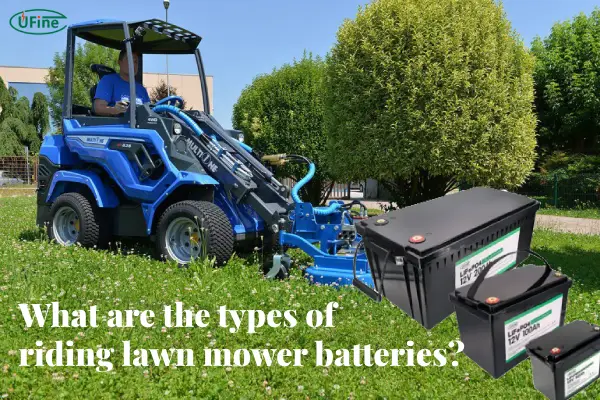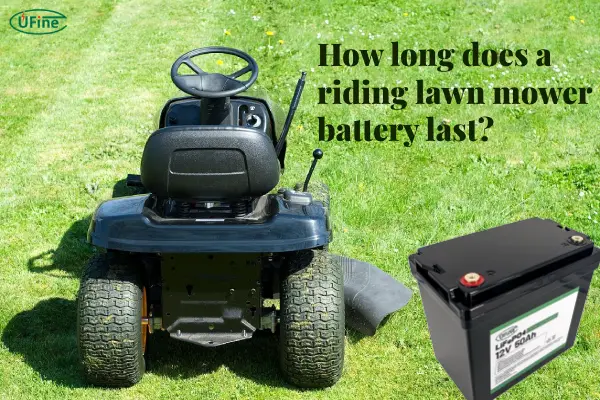Part 1. How does a riding lawn mower battery affect performance?
Imagine starting your mower on a sunny Saturday morning, only to find it sluggishly cranking before finally giving up. This scenario often results from a weak or inappropriate battery. The performance of your riding lawn mower hinges on its battery’s power capacity and reliability. A strong battery ensures quick starts, allowing you to tackle your mowing tasks efficiently.
Part 2. What are the types of riding lawn mower batteries?
When choosing a riding lawn mower battery, understanding the different types available is crucial. Here are the primary battery types, each with distinct characteristics:
-
Lead-Acid Batteries: These are the most widely used batteries for riding mowers. They come in two varieties: flooded (wet cell) and sealed (AGM). Flooded batteries require regular maintenance, including checking electrolyte levels, while AGM batteries are sealed and maintenance-free.
-
Lithium-Ion (LiFePO4)Batteries: Increasingly popular, these batteries are lightweight, charge quickly, and have a longer lifespan compared to traditional lead-acid batteries. Though initially more expensive, they offer better performance and lower maintenance costs over time.
-
Gel Cell Batteries: These batteries contain a gel-like electrolyte, making them spill-proof and safe for various applications. Like AGM batteries, they require minimal maintenance but typically have a shorter lifespan compared to lithium-ion batteries.
AGM VS Lithium VS Lead-Acid Battery: Comprehensive Comparison
Part 3. Common voltage, capacity, size, and weight
Voltage
Most riding lawn mowers operate on a 12V battery system. However, some older models may use 6V batteries. Ensuring that the voltage matches your mower’s specifications is critical for optimal performance.
Capacity
Capacity is measured in ampere-hours (Ah), which indicates how long a battery can provide a certain amount of current. Typical riding lawn mower batteries range from 18Ah to 35Ah. A higher capacity battery will power your mower longer between charges, making it ideal for larger lawns.
Size
Batteries come in various sizes based on the model of your mower. Common sizes include U1, U1R, and U1L. Always refer to your mower’s manual to confirm the correct battery size for a proper fit.
Weight
Weight can vary significantly between battery types. Lead-acid batteries often weigh between 15-25 lbs, while lithium-ion batteries can weigh under 10 lbs. A lighter battery may improve maneuverability, but you must also consider the trade-offs in performance.
Part 4. Buying a riding lawn mower battery: key considerations
When selecting a riding lawn mower battery, several key considerations should guide your choice:
-
Battery Type: Decide between lead-acid, lithium-ion, or gel batteries based on your budget and performance needs. For instance, if you prioritize maintenance-free operation, an AGM battery might be the best choice.
-
Voltage: Ensure that the voltage is compatible with your mower. Most require a 12V battery, but it’s essential to verify.
-
Capacity: Look for a battery with sufficient capacity to handle the size of your lawn. If you have a large yard, investing in a higher Ah rating will pay off.
-
Size: Always check the size compatibility with your mower. A battery that doesn’t fit can lead to poor connections and performance issues.
-
Cold-Cranking Amps (CCA): For regions with colder climates, a battery with a higher CCA rating will ensure reliable starts in low temperatures.
-
Maintenance Needs: Consider how much maintenance you’re willing to perform. Flooded batteries require regular water checks, while lithium-ion and AGM batteries typically need less attention.
-
Price: While cheaper batteries may be tempting, consider their longevity and performance. Sometimes, spending a little more can save you money in the long run through fewer replacements.
Part 5. How long does a riding lawn mower battery last?
On average, a riding lawn mower battery has a lifespan of 3 to 5 years. However, various factors can influence this duration. Frequent use, extreme weather conditions, and inadequate maintenance can shorten battery life. For instance, a homeowner named Tom found that regularly charging his battery and keeping it clean extended its life significantly.
To maximize your battery’s lifespan, perform routine checks and maintenance. If you notice slow cranking or reduced performance, it may be time to consider a replacement.
Part 6. Price
The price of a riding lawn mower battery varies depending on its type and features:
-
Lead-Acid Batteries: These typically cost between $40 and $75, making them an economical choice for many homeowners.
-
Lithium-Ion Batteries: These high-performance batteries can range from $100 to $250. While they require a higher initial investment, their long lifespan and efficiency often justify the cost.
-
Gel Cell Batteries: Prices generally fall between $75 and $150. They offer a good balance between cost and maintenance.
Consider your budget carefully, but also weigh the benefits of each battery type against their costs. Sometimes, the higher initial expense can lead to lower long-term costs due to increased reliability and durability.
Part 7. How to choose a charger for a riding lawn mower battery?
Selecting the right charger is just as crucial as choosing the battery itself. Here’s how to ensure you get a suitable charger:
-
Voltage Compatibility: Ensure the charger matches the voltage of your battery (most commonly 12V).
-
Amperage: A higher amperage charger will charge your battery faster. However, be cautious not to overcharge. Smart chargers that stop charging when the battery reaches full capacity are ideal.
-
Battery Type: Use a charger compatible with your battery type. For example, AGM batteries require a different charging approach compared to flooded batteries.
Part 8. What are the signs that a riding lawn mower battery needs to be replaced?
Here are key indicators that your riding lawn mower battery may be nearing the end of its life:
-
Slow Starts: If your mower struggles to crank or start, it may be a sign of a weakening battery.
-
Frequent Recharging: If you find yourself recharging more often than usual, your battery might be losing its ability to hold a charge.
-
Visible Corrosion: Check the battery terminals for corrosion. This can indicate poor connections and potential battery failure.
-
Age: If your battery is approaching the 3 to 5-year mark, it’s wise to monitor its performance closely.
-
Dim Lights: If your mower’s headlights dim or flicker, this could be a sign that the battery is not supplying enough power.
Recognizing these signs early can save you from the inconvenience of a dead battery in the middle of mowing.
Part 9. How to replace a riding lawn mower battery?
Replacing your riding lawn mower battery doesn’t have to be daunting. Follow these straightforward steps:
-
Turn Off the Mower: Always start by ensuring the mower is turned off and the key is removed for safety.
-
Locate the Battery: Find the battery compartment, often located under the seat or near the engine.
-
Disconnect the Terminals: Use a wrench to loosen and disconnect the negative terminal first (marked with a “-”) to prevent any electrical short, followed by the positive terminal (marked with a “+”).
-
Remove the Old Battery: Carefully lift the old battery out of its compartment.
-
Install the New Battery: Place the new battery into the compartment, ensuring it’s secure and stable.
-
Reconnect the Terminals: Attach the positive terminal first, then the negative terminal to ensure a secure connection.
-
Test the Mower: Start your mower to ensure the new battery is functioning properly. Listen for a quick and steady crank.
-
Dispose of the Old Battery: Take the old battery to a recycling center. Proper disposal is crucial for environmental protection.
Following these steps will ensure your mower is ready to tackle your yard efficiently and effectively.
Part 10. Final words
Choosing the right riding lawn mower battery is vital for ensuring that your mower operates at peak performance. With an understanding of the various types of batteries, key specifications, and essential maintenance tips, you can make an informed choice that fits your mowing needs. Remember, a high-quality battery not only enhances your mowing experience but also prolongs the life of your equipment. By investing in the right battery and charger, you can enjoy many seasons of seamless lawn
Related Tags:
More Articles

How to Choose the Best Floor Scrubber Battery for Commercial Cleaning?
Selecting the ideal floor scrubber battery ensures a long runtime, rapid charging, and minimal maintenance for efficient commercial cleaning operations.
Battery for Blower vs Battery for Leaf Vacuum: Which One Should You Choose?
Battery for blower vs leaf vacuum—learn the key differences in power, fit, and runtime to choose the right battery for your outdoor tool needs.
How to Choose the Right Battery for Blower?
Choosing the right blower battery? Consider voltage, capacity, chemistry & usage. This guide helps match the best battery for peak performance.
How to Choose the Best Insulated Battery Box for Lithium Batteries?
Choosing the Best Insulated Battery Box for Lithium Batteries? Discover key factors such as size, material, and safety for optimal protection and performance.
7 Critical Elements on a Lithium Battery Shipping Label
What must be on a lithium battery shipping label? Learn 7 key elements to ensure safety, legal compliance, and correct handling across all transport modes.





